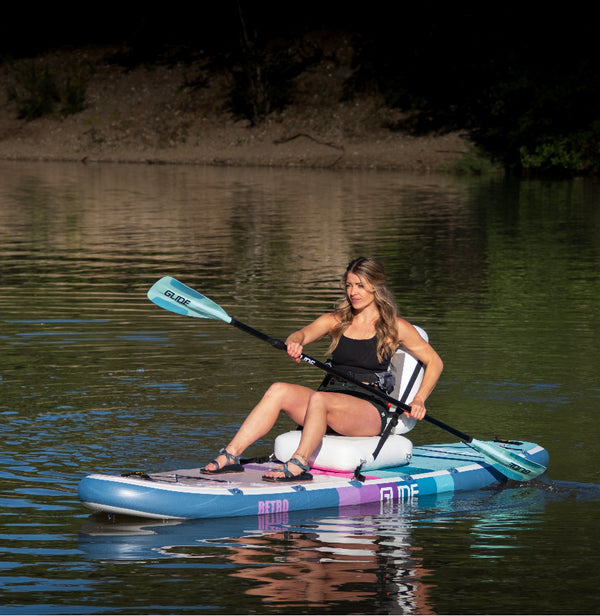
Sit-On-Top Kayaking 101: A Beginner’s Guide
If you’re looking to dip your toes into the world of kayaking, you’ve come to the right place. Sit-on-top kayaking is an excellent way for beginners to get started. It's user-friendly, versatile, and perfect for a wide range of water conditions.
If you’re looking to dip your toes into the world of kayaking, you’ve come to the right place. Sit-on-top kayaking is an excellent way for beginners to get started. It's user-friendly, versatile, and perfect for a wide range of water conditions. Whether you're planning a leisurely paddle on a calm lake or an exciting day on the ocean, sit-on-top kayaks have got you covered. Let’s dive into everything you need to know about sit-on-top kayaking.

What is a Sit-On-Top Kayak?
Sit-on-top kayaks are just what they sound like – kayaks where you sit on top rather than inside. Unlike traditional kayaks, these are designed with an open-top, making them incredibly easy to get on and off. They’re typically wider and more stable, making them ideal for beginners and casual paddlers.
Benefits of Sit-On-Top Kayaks
-
Ease of Use: Sit-on-top kayaks are incredibly user-friendly. The open design means you don’t have to worry about getting stuck inside if you capsize.
-
Stability: These kayaks are wider and more stable than their sit-inside counterparts, making them less likely to tip over.
-
Versatility: Perfect for various activities like fishing, diving, and casual paddling. You can easily hop off for a swim and get back on without much hassle.
-
Self-Bailing: Most sit-on-top kayaks come with scupper holes that allow water to drain out, so you don’t have to worry about water accumulating in the cockpit.
The Glide Advantage: Convertible Paddle Boards

Here’s a fantastic option for those who want the best of both worlds: Glide inflatable paddle boards. These boards come with a kayak seat, allowing them to be easily converted into a sit-on-top kayak. This versatility means you can enjoy paddle boarding one day and kayaking the next, all with the same equipment.
Choosing the Right Sit-On-Top Kayak
When choosing a sit-on-top kayak, consider the following factors:
-
Length and Width: Longer kayaks are faster and track better, while shorter kayaks are more maneuverable. Wider kayaks offer more stability.
-
Weight Capacity: Make sure the kayak can comfortably support your weight along with any gear you plan to bring.
-
Features: Look for features like comfortable seating, storage compartments, and accessories like rod holders if you plan to fish.
Essential Gear for Sit-On-Top Kayaking
-
Paddle: A good quality paddle that suits your height and paddling style.
-
PFD (Personal Flotation Device): Always wear a PFD for safety.
-
Sun Protection: Sunscreen, hat, and sunglasses to protect against UV rays.
-
Clothing: Wear moisture-wicking and quick-drying clothes. A wetsuit may be necessary for colder waters.
-
Safety Gear: A whistle, a bilge pump, and a paddle leash are essential for safety.
Getting Started with Sit-On-Top Kayaking
-
Launching Your Kayak: Place your kayak in shallow water. Sit on the edge and swing your legs over to straddle the kayak. Use your paddle for balance as you settle into your seat.
-
Basic Paddling Techniques: Hold your paddle with both hands, shoulder-width apart. Dip the paddle blade fully into the water near your toes, pull back in a smooth, sweeping motion, and lift out of the water near your hip. Alternate sides to propel yourself forward.
-
Steering and Turning: Use wide, sweeping strokes on one side to turn your kayak. To make sharper turns, paddle backward on the opposite side.
Tips for a Great Kayaking Experience
-
Start Slow: Begin in calm, shallow waters to get a feel for your kayak.
-
Practice Re-Entry: Learn how to get back on your kayak from the water. It’s a crucial skill in case you capsize.
-
Stay Hydrated: Bring plenty of water and snacks, especially for longer trips.
-
Know the Weather: Always check the weather forecast before heading out. Avoid kayaking in strong winds, heavy rain, or storms.
-
Buddy Up: Kayaking with a friend is not only more fun but also safer.
Common Mistakes to Avoid
-
Overpacking: Don’t overload your kayak with too much gear. It can affect stability and maneuverability.
-
Ignoring Safety Gear: Always wear your PFD and carry necessary safety equipment.
-
Poor Posture: Maintain good posture by sitting upright. Slouching can lead to back pain and inefficient paddling.
-
Neglecting to Secure Gear: Use bungee cords or storage hatches to secure your gear and prevent it from falling overboard.
Conclusion

Sit-on-top kayaking is a fantastic way to explore the water, enjoy nature, and get some exercise. With its ease of use and versatility, it’s no wonder it’s a popular choice for beginners. By following this guide, you'll be well on your way to having fun and safe adventures on your sit-on-top kayak. And remember, with Glide inflatable paddle boards, you get the added benefit of a kayak seat, allowing you to seamlessly switch between paddle boarding and kayaking. So grab your paddle, put on your PFD, and hit the water – adventure awaits!


